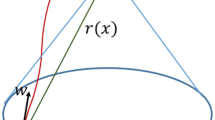Abstract
The physical origin of inertial forces is shown to be a consequence of the local interaction of Dirac's real covariant ether model(1) with accelerated microobjects, considered as real extended particlelike solitons, piloted by surrounding subluminal real wave fields packets.(2) Their explicit form results from the application of local inertial Lorentz transformations to the particles submitted to noninertial velocitydependent accelerations, i.e., constitute a natural extension of Lorentz's interpretation of restricted relativity.(3) Indeed Dirac's real physical covariant ether model implies inertial forces if one considers the real accelerated noninertial motions of general relativity, defined within the absolute local inertial frames associated with the observed local isotropy of the 2.7° K background microwave radiation.(4) Inertia thus appears as a necessary consequence of the real particle motions described by the E.d.B.B. formalism of quantum mechanics.
Similar content being viewed by others
References
P. A. M. Dirac,Nature (London) 168; 906 (1951).
For a review of this proposal, see J. P. Vigier,Found. Phys. 21, 125 (1991).
H. A. Lorentz,Versus einer Theorie der electrischen und optischen Erscheinungen in bewegten Körpern (Bri, Leiden, 1895).
M. C. Combourieu and J. P. Vigier,Phys. Lett. A 175, 269 (1993). For a review of the present state of the Lorentz interpretation of relativity theory, see “Analysis of absolute space-time Lorentz theories,” A. K. A. Maciel and J. Tiomno,Found Phys. 19, 505 (1989).
E. Mach,Science of Mechanics, 9th edn. (1983) (Open Court, London, 1933).
A. Einstein, “Uber den Ather,”Verh. Schweiz. Naturf. Ges., 85 (1905).
B. Haisch, A. Rueda, and H. E. Puthoff,Phys. Rev. A 49, 678 (1994).
A. S. Eddington,Report on the Theory of Gravitation, Phys. Soc. London (Fleetway Press, London, 1920). A. K. T. Assis, “On Mach's principle,”Found. Phys. Lett. L2, 301 (1989). D. W. Sciama, “On the origin if inertia,”Royal Astron. Soc. Month. Not. 113, 34 (1953). P. and N. Graneau,Newton versus Einstein (Carlton, New York, 1993). J. Larmor,Ether and Matter (Cambridge University Press, Cambridge, 1900).
W. Rindler, “The Lense-Thirring effect exposed as anti-Machian,”Phys. Lett. A 187, 236 (1994).
B. Mashoon,Nuovo Cimento Lett. 39, 337 (1984).
K. P. S. Sinha, E. C. G. Sudarshan, and J. P. Vigier,Phys. Lett. A 114, 298 (1986).
L. de Broglie,Une tentative d'interprétation causale et non-linéaire de la mécanique ondulatoire (Gauthier-Villars, Paris, 1956). D. Bohm,Phys. Rev. 85, 166 (1952).
The next pages on relativity and inertia up to relation (10) follow the exposition given by E. Tocaci,Relativistic Mechanics, Time and Inertia (Reidel, Dordrecht, 1984).
E. Whittaker,History of the Theories of Ether and Electricity (Thomas, London, 1953).
A. Einstein, “Electrodynamic bewegter Körper,”Ann. Phys. (Leipzig) 17, 891 (1905).
F. Rohrlich,Ann. Phys. 22, 169 (1969).
L. Mishra, private communication.
W. Rindler and L. Mishra, “The non-reciprocity of relative acceleration in relativity,”Phys. Lett. A (1994), in press.
L. Mishra, “The relativistic acceleration theorem,”Class. Quant. Grav. L97 (1994).
G. Builder, “Ether and relativity,”Austr. J. Phys. II, 279 (1958).
E. A. Desloge,Found. Phys. 19, 1191 (1989).
For a review of this question, see J. P. Vigier,IEEE Trans. Plasma Sci. 18, 64 (1990).
D. Bohm and J. P. Vigier,Phys. Rev. 109, 1882 (1958). H. Yukawa,Scientific Work (Iwanami Shoten, Tokyo, 1979).
J. M. Souriau, F. Halbwachs, and J. P. Vigier,J. Phys. Rad. 22, 26 (1961). F. Halbwachs,Théories relativistes fluides à spin (Gauthier-Villars, Paris, 1960).
L. de Broglie,Thèse (Paris, 1924). See also “Lathermodynamique de la particule isolée (Gauthier-Villars, Paris, 1960).
N. Cufaro-Petroniet al., Phys. Rev. D. 32, 1375 (1985).
A. Kyprianidis and D. Sardelis,Nuovo Cimento Lett. 39, 337 (1984).
D. Bohm and J. P. Vigier,Phys. Rev. II 96, 208 (1954).
P. Garbaczewski and J. P. Vigier,Phys. Rev. A 46, 4634 (1992).
N. Cufaro-Petroni and J. P. Vigier,Found. Phys. 22, 1 (1992).
J. P. Vigier,Pramana J. Phys. 25, 397 (1985). L. de Broglie and J. P. Vigier,La physique quantique restera-t-elle indéterministe? (Gauthier-Villars, Paris, 1953). J. P. Vigier,Found. Phys. 21, 125 (1991).
J. P. Vigier,Found. Phys. 24, 61 (1994). J. S. Bell, private communication.
Ch. Fenech and J. P. Vigier,Phys. Lett. A 37 (1993).
J. P. Vigier,Astr. Nach. 303, 61 (1982).
Author information
Authors and Affiliations
Rights and permissions
About this article
Cite this article
Vigier, JP. Derivation of inertial forces from the Einstein-de Broglie-Bohm (E.d.B.B.) causal stochastic interpretation of quantum mechanics. Found Phys 25, 1461–1494 (1995). https://doi.org/10.1007/BF02057462
Received:
Revised:
Issue Date:
DOI: https://doi.org/10.1007/BF02057462




